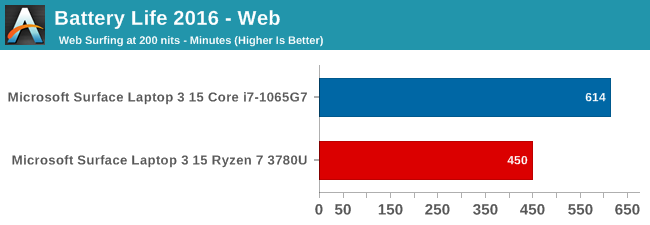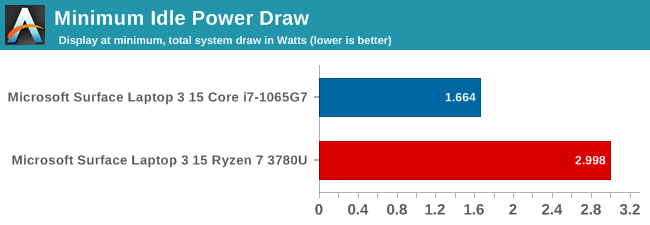The Microsoft Surface Laptop 3 Showdown: AMD's Ryzen Picasso vs. Intel's Ice Lake
by Brett Howse & Andrei Frumusanu on December 13, 2019 8:30 AM ESTPlatform Power
Performance aside, the other side of the coin is battery life. AMD made big gains in battery life with the Ryzen 3000 series, somewhat addressing the power requirements of the platform and getting rid of some of the excessive idle power draw, but they are still using DDR4 on their mobile platform, which puts them at a disadvantage right out of the gate. Intel has made very good gains in battery life over the last several generations, and the move to 10 nm for Ice Lake also brought along LPDDR4X support. Most of the previous generation laptops stuck with LPDDR3, unless the manufacturer needed more than 16 GB of RAM, where they’d be forced to switch to DDR4. Finally adding LPDDR4X support is something that Intel has needed to do for a while, and ironically Intel’s flagship Core product line lagged behind their low-cost Atom lineup which did support LPDDR4.
Web Battery Life

The Ryzen 7 3780U powered Surface Laptop 3 was slightly under the Ryzen 5 device we tested at launch, but still in the same range. The AMD system isn’t helped very much by Microsoft only offering a 46 Wh nominal battery capacity, which is rather undersized for a 15-inch laptop. The Ice Lake device, as we’ve seen before, was much more efficient under load, offering a sizeable battery life lead.
Idle Power
One of AMD’s biggest challenges was to get their laptop SoC into a premium device, and with the Surface Laptop 3 they have succeeded. Microsoft has shown themselves as being adept at squeezing battery life out of devices, with low-power displays, and good internal components to minimize power draw. Here Intel has held a considerable advantage over the last couple of years, and the move to 10 nm should, in theory, help as well.
To test the idle power draw of both systems, the battery discharge rate was monitored with the screens fixed in at 5.35 nits, to minimize the power draw of the display on the result. Normally we’d prefer to have the display completely off for this test, but Microsoft’s power plan on the Surface Laptop actively turns off the laptop when the display times out.

The Ice Lake system was able to go all the way down to right around 2 Watts of power draw – and sometimes slightly under – with as low as 1.7 Watts seen. We’ve seen under 1 Watt of draw on an 8th generation Core Y series processor, and around 1.5 Watts on the same generation U series, so considering the display is not completely off on the Surface Laptop, the 2-Watt draw is quite reasonable.
The Picasso system was not quite as efficient, drawing 3 Watts at idle. This is in-line with the results we’ve seen on other Picasso systems and explains the lower battery life results on the AMD system. AMD made big gains moving from Raven Ridge to Picasso, but I’m sure the team is looking forward to the 7 nm Zen 2 coming to their laptops, which we hope will address this further.










174 Comments
View All Comments
maroon1 - Sunday, January 12, 2020 - link
You mean LPDDR4XThere is big difference between LPDDR4 and LPDDR4X in speed
Llawehtdliub - Saturday, December 14, 2019 - link
Latest Intel CPU vs AMD's year old CPU.Doesn't seem very fair.
Brett Howse - Saturday, December 14, 2019 - link
And yet this is what is available as current gen products.m53 - Saturday, December 14, 2019 - link
It is as fair as comparing 5 year old Skylake with latest Zen2 desktop. The only difference is Skylake actually beats Zen2 if we compare “equal core count” parts. But here Zen+ is simply getting slaughtered by Ice Lake.0ldman79 - Tuesday, December 17, 2019 - link
This is Ice Lake, not Skylake.Not a 5 year old design.
This is, however, the two products that Microsoft has available to choose from.
Korguz - Tuesday, December 17, 2019 - link
m53. i doubt skylake can beat zen2, clock for clock, or core for core....0ldman79 but is based on a 5 year old design, so basically the same thing, hence why is 10th generation, not 1st generation
MBarton - Monday, December 30, 2019 - link
Wow, such a fanboy statement from a guy that whined about that fatality guy being a fanboy.maroon1 - Tuesday, December 17, 2019 - link
WRONGRyzen 7 3780U came out this year.
It is based on 12nm Zen+ but AMD low power mobile is almost 1 year behind their desktop parts
Zen2 APU will be out in 2020, but intel will also have Tiger lake-U in 2020.
AnnoyedGrunt - Saturday, December 14, 2019 - link
I thought the article was very fair, given what is available from AMD and Intel in the mobile space.While these benchmarks show convincingly in favor of Intel, I was wondering if the performance difference was noticeable in "normal" user. Seems like the battery life is likely to be the most significant difference between the two (that the user would notice).
Have the authors been able to use these systems day to day to see what the responsiveness is like, whether you notice a difference loading office software, doing presentations, running excel, chrome, safari, etc?
I have a Dell mobile workstation for work, and just started testing a desktop workstation, and while I'm sure the desktop is faster in tests like these, I honestly don't notice a performance difference at all, except in the heaviest CAD work. Therefore I am curious of a user could really notice a difference between these two systems in typical use.
-AG
Samus - Saturday, December 14, 2019 - link
Ouch, well that's embarrassing.Why the hell did Microsoft even bother with a Ryzen model when its so inferior?